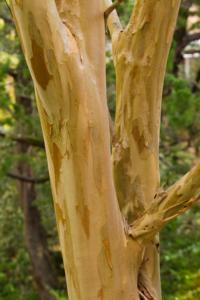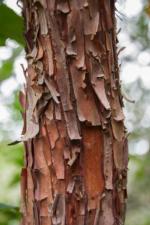Trees with interesting bark shine in winter
-
Winter brings out the structural elements of the landscape. Trees and shrubs with colorful or textured bark can be real eye-catchers when they're not competing with flashy flowers or fancy foliage. Some deciduous specimens look especially beautiful when their branches are naked. Here are examples of trees and shrubs whose handsome bark can add a new dimension to your winter garden.
California buckeye (Aesculus californica) -- It's hard not to notice this tree in winter when large, pear-shaped seed pods hang from its bare branches like ornaments. The smooth gray bark turns silvery with age. In early spring, candle-like spikes of fragrant white or rose flowers put on a show. This California native is drought tolerant, but its leaves can turn brown and drop by July. 10 x20' tall x 30' wide.
Chilean myrtle (Luma apiculata) -- With attractive bark, flowers and berries, this fast-growing shrub or small tree makes a good specimen. The smooth bark is cinnamon-brown and peeling on older plants. The small, dark green leaves are aromatic. White or pale pink flowers in summer are followed by blue-black berries. 6-15' x 6-20'.
Chinese elm (Ulmus parvifolia) -- Mottled bark, weeping branchlets and dainty leaves are characteristic of this semi-evergreen tree. It is fast growing with a broad canopy, making it an excellent dappled-light shade tree. It takes full sun and moderate water. Look for named varieties of the Chinese elm -- some are more or less evergreen and differ in leaf size and weeping habit. Avoid 'True Green' or 'Evergreen' as these are highly susceptible to leaf diseases. 'Drake' is a resistant variety. 40-60' x 60'.
Coral bark maple (Acer palmatum 'Sango Kaku') -- The branches and twigs of this tree gleam coral red in winter, while the trunk provides contrasting green tones. Younger branches (one or two years old) are the reddest; chilly weather also enhances the color. As the tree ages, the oldest branches take on a brownish green tinge. Foliage turns yellow in fall before dropping. Its upright from can be pruned to the desired size.
Cork bark Japanese maple (Acer palmatumm 'Arakawa') -- This small specimen tree is highly coveted for its cork-like bark that gains more interest with age. Fiery red foliage in autumn provides a spectacular display. It has a low canopy, with branches starting at about 3' from the ground. It prefers average to moist conditions and should not be allowed to dry out. 15' x 15'.
Cork oak (Quercus suber) -- If you ever wondered where that cork in your wine bottle comes from, this tree is the source. The trunk and main branches of this evergreen oak are covered with thick, heavily fissured bark. Its acorns are egg-shaped, up to 1 1/2'' long. Cork oaks make good shade trees and are fairly tolerant of different soil types. Mature cork oaks, however, do not like summer water, so they do not make good lawn trees. 30-60' tall and wide. Crape myrtle
Crape myrtleCrape myrtle (Lagerstroemia indica) -- The smooth gray-brown mottled bark of this small tree begs to be touched. White, pink or reddish -purple flowers from July to September are followed by an autumn display of orange-red leaves. The heat-loving crape myrtle can be found on patios and curbsides throughout Marin. 25' x 15-25'.
Harry Lauder's walking stick (Corylus avellana 'Contorta') -- Contorta is a perfect name for this shrub, which reveals its fantastic form after its leaves drop in autumn. The twisted, corkscrew branches make handsome indoor arrangements or a stunning outdoor sculpture when planted within view of a window. Hanging catkins dot the branches in early spring. 8-10' x 8-10'.
Japanese Stewartia (Stewartia pseudocamillia) -- The smooth bark of this small tree flakes off to reveal a camouflage pattern of orange, gray, green and tan. But you'll love this tree even more for its camellia-like flowers in summer--white petals with orange anthers. In fall, the deciduous foliage turns red to purple. Stewartia dislikes intense heat and drought, and should be planted where its year-round beauty can be admired. It's a slow grower, reaching 30-40' x 20-25' after many years.
Madrone (Arbutus menziesii) -- Beloved by local hikers, the madrone is a forest beauty with its smooth cinnamon bark that peels like paper. It has shiny, dark green leaves, clusters of small bell-shaped flowers in spring and orangish-red berries in fall and winter. Sadly, this California native is too picky to grow in most garden settings. It requires fast drainage and, once established, likes only infrequent deep watering. Consider instead two worthy alternatives.- Strawberry tree (Arbutus unedo) -- The trunks and branches of this adaptable tree have red-brown bark with a shredded look. Peeling older bark reveals shiny, reddish new bark. Typically multi-trunked, the strawberry tree has dark green leaves and dangling clusters of tiny white flowers. Its small round fruit has the rough texture of strawberries but tastes rather bland. Turning from yellow to red, the fruit lights up the tree in fall and winter. A great performer in Marin gardens, the strawberry tree tolerates a variety of climates and soils, sun or part shade, wind and regular to little water. 15-30' tall and wide. 'Elfin King' is a dwarf form that grows to about 6' tall.
 Strawberry tree
Strawberry tree - Arbutus 'Marina' is a hybrid with striking cinnamon-red new bark that is constantly peeling to show smooth, multi-hued layers underneath. The flower clusters are pinkish-white. It makes an excellent specimen tree, either with a single or multi-trunk, and is suited to many conditions. 30' tall and wide, but usually less.
Paperbark (Melaleuca quinquenervia) -- This Australian native has shaggy, peeling bark. The flowers in summer and fall look like little bottlebrushes. A good street tree, it tolerates heat, wind, salt spray, poor soil and drought. Paperbark can be invasive in some parts of California so should not be planted next to wildland areas. 20-40' x 15-25'.
Redtwig dogwood (Cornus stolonifera) -- Aptly named, the branches of this deciduous shrub make a statement in winter. Brilliant red foliage in fall and creamy white flower clusters in summer are also noteworthy. When selecting a planting site, be aware that this is a water-loving shrub and can spread by underground stems or branches that touch the ground. It works well for retaining soil on banks or as a screen along a property line. The younger branches are the reddest, so in early spring, cut off 2-year-old stems and head back 1-year-old ones. Redtwig dogwoods will turn brighter red in cold winters and are stunning in snowy areas. 7-9' tall.
By Faith Brown


